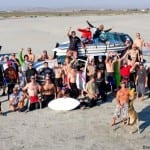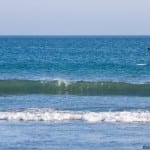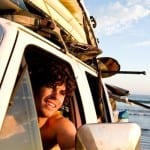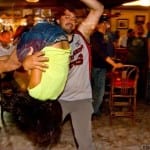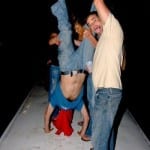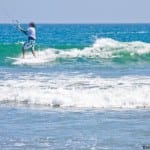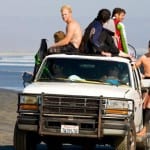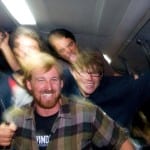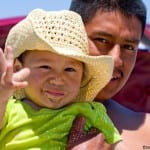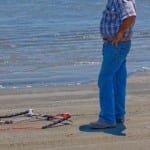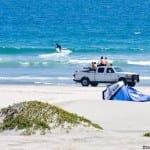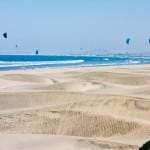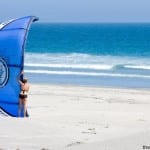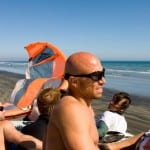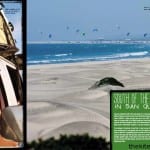South of the Border in San Quintin
Words and Photos by Paul Lang

Head 20 minutes south from San Diego on I-5 and you will find yourself in a wildly different place. As soon as you cross under the large green, white, and red sign that reads “MEXICO,” make sure you line up in one of the “Nothing to Declare” lanes and hope for a green light. A red light means you must pull over and attempt to explain yourself in broken Spanish, much to the amusement of the local authorities. A green light means “Bienvenido a Mexico,” and you continue onward into a new country.
The change is shocking: In less than 10 feet, you go from being in an organized, slow moving lane to a complete free-for-all in which everyone, especially the taxi drivers, seems to completely ignore all rules of the road. Stay alert and keep your eyes open for the sign that will lead you south out of town to the toll road for Ensenada. Breathe another sigh of relief once on the toll road. This sigh is because you know you are already through Tijuana, and you have heard the stories about what has been happening there.
{openx:86112}
TRAVELING TO BAJA
Anyone who has been to Mexico knows the country is full of some of the warmest and friendliest people on the planet, but unfortunately Mexico is also home to widespread poverty, corruption, drug and human trafficking, and organized crime. Tourism in Mexico, especially in Baja, has plummeted in recent years, due to the stories that are reported about the incidents that happen there. To explore Baja, most people cross through Tijuana where hundreds of criminals, police officers, and innocent bystanders died in 2008 due to the violence caused by organized crime.
The fact that the stories about violence in the border region are picked up and sensationalized by the media only makes the problem worse and has caused some people I know who have been traveling to Baja for more than 20 years to swear off heading south of the border completely. The saddest part of all of this is that the rest of the country is not at all like Tijuana and the other border regions ”” there are endless and incredible kiteboarding opportunities all over the more than 2,000 miles of Baja coastline.

THE REAL BAJA
To continue offering kiteboarding trips to San Quintin, a sleepy farming town 200 miles south of the border, the crew at Calikites came up with a bold idea: Instead of bringing kiters down in a 15-passenger van, they would rent a 50-person charter bus and completely take over the Desert Inn, a bunker-like beachfront hotel sitting in the middle of 12 miles of pristine sandy beach. They would also drag down a rescue jet-ski, a van full of demo gear from Liquid Force, Cabrinha, and North, and a pile of SUP boards in case the wind didn’t show.
Because of the recent troubles in Baja, it was unclear how many kiteboarders would be willing to travel down, but the buzz about how good the kiting is in San Quintin was enough to quickly fill the bus to capacity. Early on a Friday morning, the bus was loaded up behind the Calikites shop in Coronado with eager kiteboarders and tons of gear for the five-hour drive down. We quickly passed through Tijuana and were on our way to three days of kiteboarding in the real Baja California.
SAN QUINTIN
As soon as the bus was unloaded and everyone found their ocean-view rooms (every room at this hotel has an ocean view), the quiet beach was invaded by a hoard of kiteboarders eager to get on the water. San Quintin is the perfect place for beginner-intermediate kiteboarders to ride, as the wind blows anywhere from side-on to slightly side-off and there are no obstacles, except for the cars parked on the beach. The waves are usually very small and the wind is steady. This section of the Baja Coast is where deep ocean water is pushed up near the surface, so the water can be cold, typically 5-10° colder than San Diego.
{openx:86112}
Kite sizes in San Quintin can range from 6-16 meters, depending on the season, but after more than a dozen trips here, I’ve ridden every single time. After a little water time, everyone packed up their gear and headed back to their rooms for hot showers to wash off the incredibly fine beach sand that manages to get everywhere before heading a few miles down a dirt road to the Cielito Lindo for dinner, drinks, and dancing. According to one rumor, John Wayne and Henry Fonda once frequented the Cielito Lindo, but now it’s the spot for good food, cheap drinks, good dancing with locals, and a chance to meet a few of the local ex-pat American characters, most of whom look like there could have been a Jimmy Buffett song written about them. Watch out for the margaritas here, they’re strong enough that they may have to find the wheelbarrow that’s always nearby (the locals call it the limo) to get you back to your bed.
On the way back to the hotel, most of the people in the bus ended up riding back on the roof of the bus, which, for some reason, is just the sort of thing that always seems to happen down here.

DAY TWO
The next day, after sleeping off all of the excesses of the night before, everyone found their way to the beach and pumped up. The wind stayed fairly light, but most were able to get out and ride on 12-16 meter kites. Beginners worked on riding upwind or learning to jump while more experienced riders played in the small waves or used the shorebreak as a kicker to throw tricks. The amount of kiters on this trip was an unbelievably large group for San Quintin, so locals began showing up to watch the crazy gringos. Downwinders were organized and groups would take off and head the six or so miles downwind to the end of the beach, then pile into the Calikites truck to be brought back upwind. After a full day on the beach, everyone jumped into the bus to head to Jardines, a few miles up the road towards town.
Jardines is the type of place that makes Baja special. To get there, you turn off the main road and ramble down a washboard dirt road through a field for about a mile and then come to a beautify maintained garden full of all kinds of exotic plants and one of the most beautifully manicured lawns I’ve ever seen. In the midst of this unexpected oasis is a restaurant that serves great food and a small hotel with rooms starting at $35 a night. After dinner and a few (OK, many) drinks, a slideshow and raffle were put on back at the Desert Inn, and a few intrepid people found out that not only do ice chests keep food and beer cold, but you can also fit two adults in one and ride it down a set of stairs.
DAY THREE
Most people slept in on Sunday and then hit the beach, but it seemed like the whole town had heard of all of the kiteboarders riding in front of the hotel and had come down to watch. This created a bit of a traffic jam on the beach near the hotel, but since the beach is 12 miles long, there was still plenty of room for everyone to spread out. The Calikites truck was working full time bringing people back upwind after hour-long downwinders. While walking on the beach a local waved me over to join him and his family. They had an awning tied up between an old car and older van, under which the women were at work preparing a giant bowl of fresh ceviche. I was promptly given a heaping bowl and a few tortillas and they asked me to stay and eat with them. As soon as I finished, one of the older women handed me a sandwich gently wrapped in a paper towel. “Fresas,” she said, the jam on the sandwich being homemade strawberry jam. I stayed with the family for a few minutes, took a few pictures, and said goodbye to them and wandered off to get in some more water time before heading back up north on the bus.

Shortly after one more session, the bags were packed, the bus was loaded, and we were on the road, leaving the real Baja behind in order to go back to our real jobs. Despite all of the bad news about violence in Mexico, a bus load of 50 kiteboarders had made it down and back without incident, and everyone involved had a blast doing it.
Fact File:
Getting to San Quintin: Drive South on I-5 and follow the signs for Road 1 once in Mexico. San Quintin has a few landing strips, so it’s possible to fly down if you find an adventurous pilot with a small plane. For an easy trip, travel with the guys from Calikites (www.calikites.com).
Where to Stay: The largest hotel closest to the beach is the Desert Inn (www.desertinns.com), $40-$80/night depending on if they’re offering a deal or not. Things may be changing soon, as this hotel was supposedly just auctioned off to a new owner. There are other places to stay nearby, including the Cielito Lindo (no website, just show up) and Jardines (near San Quintin Bay, www.hotel-jardinesbaja.com).
Where to Ride: Ride in front of the Desert Inn, or anywhere else on the amazingly long beach. On Sundays, local families flock to the beach, so you’ll have to go upwind or downwind to find a quiet spot. If you are going to drive on the beach, a four-wheel-drive vehicle and a tow strap are highly recommended. You can also ride in San Quintin Bay, where the water is warm, shallow, and flat, but the bottom is very muddy.
Where to Eat: There’s plenty of good food around. For breakfast, the restaurant in the Desert Inn is very good. The food at the Cielito Lindo and especially Jardines is excellent and very reasonably priced. If you see a taco stand with a large crowd around it, you know it’s a good one.
About traveling in Mexico: Yes, there are problems in Mexico, but you can stay well clear of them if you use your head. Mexico is not the lawless land that many Americans think it is and you cannot do whatever you want here. Treat the locals with respect and act as you would at home. If you drive your own car, get Mexican liability insurance (you can buy it online) and drive carefully. It’s safest to only drive during daytime, especially outside of the cities where there may be cows and/or horses in the road and where some locals have the habit of driving without their headlights on.
{openx:86112}



